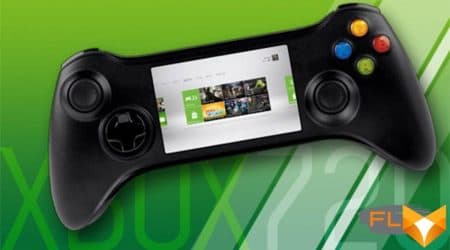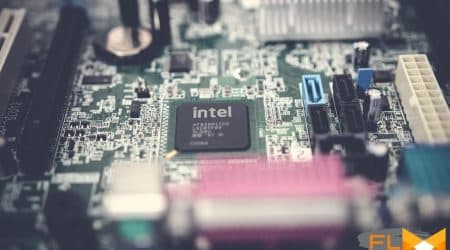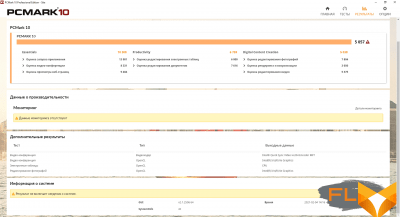


For the first time, a laptop with two screens was introduced by ASUS more than a year and a half ago. A review of such a laptop was published on FOX-laptop – we are talking about the ASUS ZenBook Pro Duo UX581GV model. Following the flagship, a little over a year ago, a version of the ZenBook Duo UX481F appeared with a much more digestible cost, and earlier this year the company released the next version of a dual-screen laptop, or rather an ultrabook, the ASUS ZenBook Duo 14 UX482.

Compared to the UX481, the new UX482 features an 11th Gen Tiger Lake processor, much faster RAM and SSD storage, a faster graphics core (or discrete graphics card), and other optimizations to improve the user experience in less time. ultrabook, including simultaneously with two displays.
⇡#Packaging
Ultrabook ASUS ZenBook Duo 14 UX482E comes in a black cardboard box with a plastic handle.
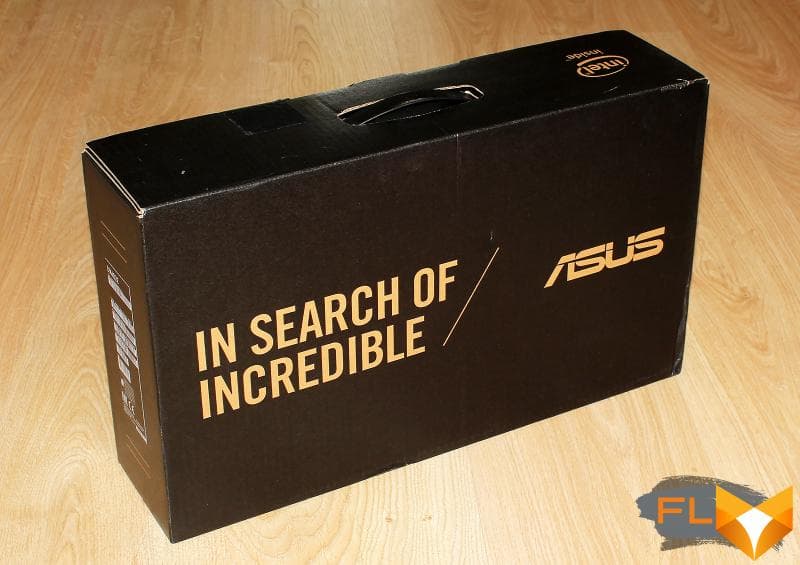
From the useful information on the box, we highlight a sticker listing the hardware components of the ultrabook.

Inside the main package, between the soft corners, another flat box is inserted, where the ultrabook is fixed.

On the side of it is a cover-envelope with orange stitching.


Also in the box you can find a stand for the ultrabook case and a power adapter with a built-in cable.


We add that this ultrabook model can also be equipped with an Asus Pen stylus, which was not in our version.
ASUS ZenBook Duo 14 UX482 is released in China and comes with a two-year warranty. The cost of the ultrabook in the configuration provided to us for testing, which you will see right next, is $ 2,700.
⇡#Specifications
| ASUS ZenBook Duo 14 UX482EA | ||
| Processor | Intel Core i7-1165G7 (10nm SuperFin, 4 cores/8 threads, 1.2-4.7GHz, 12MB L3 cache, TDP 12-28W) Options: – Intel Core i5-1135G7 |
|
| Chipset | Intel Tiger Lake | |
| RAM | 4 x 8 GB LPDDR4X 4266 MHz (dual channel, 36-39-39-97 CR1) Options: – 2 x 8 GB LPDDR4X 4266 MHz; – 8GB LPDDR4X 4266MHz |
|
| Video Subsystem | Intel Iris Xe Graphics Processor Integrated Options: – NVIDIA GeForce MX450 2GB GDDR6 |
|
| Accumulators | 1TB SSD Samsung PM981a (MZVLB1T0HBLR-00000), NVMe 3.0 x4 M.2 Options: – 512GB SSD |
|
| Display | 1) 14″ NanoEdge IPS Full HD (1920 × 1080), 60Hz, 400nits, 100% sRGB (NTSC 72%), Anti-Glare, Pantone Validated and TÜV Certified Rhineland; 2) ScreenPad Plus 12.65 inch, 1920 × 515 pixels, stylus support |
|
| Sound subsystem | Realtek ALC3288 audio codec; two stereo speakers; certification by Harman Kardon specialists; 4 microphones with Cortana and Alexa voice control |
|
| Cardreader | MicroSD | |
| Network interfaces | Cable network | None |
| Wireless | Intel Wi-Fi 6 AX201D2W 802.11ax, MIMO 2×2, 2.4 and 5.0 GHz (160 MHz) | |
| Bluetooth | Bluetooth 5.0 | |
| NFC | None | |
| Interfaces and Ports | USB 2.0 | None |
| USB 3.2 Gen1 | 1 Type-A | |
| USB 3.2 Gen2 | 2 Type-C (Thunderbolt 4, up to 40Gbps) | |
| HDMI | Yes, 1.4 | |
| VGA | Нет | |
| DisplayPort 1.4 | Нет | |
| RJ-45 | Нет | |
| Microphone input | Yes (combined) | |
| Headphone output | Yes (combined) | |
| Input Devices | Keyboard | Illuminated Chiclet membrane with function keys, ~1.4mm travel |
| Touchpad | Two-button vertical, 55 × 70 mm | |
| VoIP | Webcam | HD (30 FPS@720p) + IR with Windows Hello |
| Microphone | Yes, 4 pcs | |
| Battery | 70 Wh 4 cell Li-Ion | |
| Power adapter | AD2129320 (65W, 20.0V, 3.25A), 215g with 1.57m cable | |
| Dimensions | 324.0 × 222.0 × 19.5 mm | |
| Weight without power adapter: declared/measured | 1570 / 1583g | |
| Body color | “Celestial Blue” | |
| Other features | MIL-STD 810H compliant; Trusted Platform Module (TPM); myASUS; ScreenXpert; McAfee |
|
| Operating system | Windows 10 Pro/Home | |
| Warranty | 2 years | |
| Retail value | $2,700 | |
⇡#Design and ergonomics body
The case of ASUS ZenBook Duo 14 UX482 is made in the color with the original name “Celestial Blue”, but the shades of the case have little in common with the blue. Rather, it is blue-gray with metallic tints.
 |
 |
The display panel of the ultrabook and the working keyboard panel are made of lightweight and durable magnesium-aluminum alloy, and the base is made of plastic. On the top cover there is a silvery ASUS logo, from which concentric circles diverge. This solution looks very attractive, although it is not new for the company’s products.

On the base, we note a small ventilation grill, stickers and ultrabook markings.

The dimensions of the ultrabook are 324.0 × 222.0 × 19.5 mm (16.9 mm without legs), and it weighs 1583 grams. In working condition, ASUS ZenBook Duo 14 UX482 looks very unusual in comparison with other mobile computers. So far, the solution with two displays is the exclusive prerogative of ASUS.
 |
 |

An informational sticker with its key features is glued out of the box on the body of the ultrabook.

The case is supported by two long strips with a rubber base, glued on the front and back on the bottom edge.

Traditionally, there is nothing on the front of the ultrabook case, there is not even a recess for the fingers to open the display.

However, the edge of the display protrudes slightly forward, so it is convenient to open it and do not need to hold the base. By the way, ErgoLift screen hinges now use a zinc alloy, thanks to which it was possible to make them 30% smaller while maintaining the same strength and reliability.
The opposite end of the housing contains only two plastic stops on which the display rests when opened.

Connectors and ports in the ASUS ZenBook Duo 14 UX482E are displayed only on the sides of the case.
 |
 |
On the left is an HDMI 1.4 video output and two Thunderbolt 4 USB 3.2 Gen2 Type-C ports (up to 40 Gb / s) with support for Power Delivery, and on the right is a USB 3.2 Gen1 Type-A port (5 Gb / s), a combo connector for headphone and microphone, a slot for memory cards microSD, as well as indicators of charge and drive activity.

We add here that the ultrabook has a certificate of compliance with the American military-industrial reliability standard MIL-STD-810H, and in addition, the ZenBook Duo 14 UX482 has passed a whole series of ASUS internal tests.
⇡#Input Devices
Compared to its predecessor, the ZenBook Duo 14 UX482 keyboard has changed, in our opinion, not for the better.
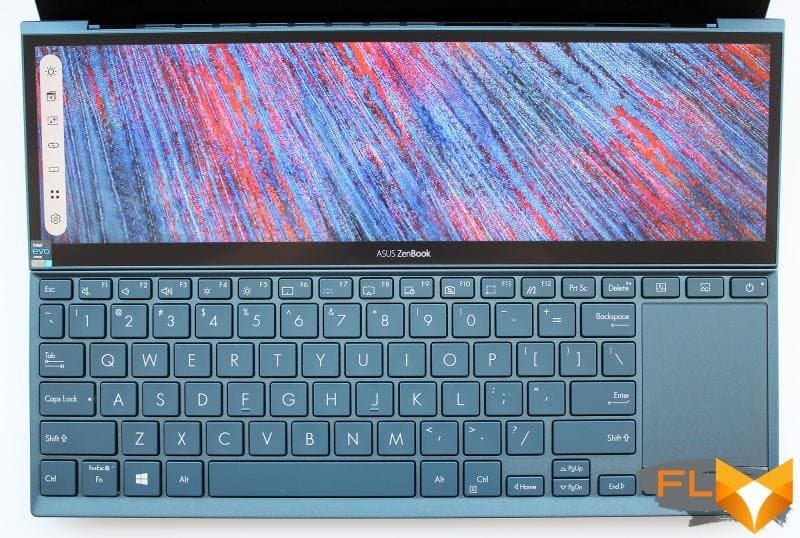
We mean up, down, left and right arrows reduced to 7 mm in height, which are also combined with PgUp and PgDn.
 |
 |
Otherwise, there are no changes. The dimensions of the main keys are 15.0 × 15.0 mm, the functional keys are 13.5 × 8.0 mm. The key travel is 1.4 mm. In our version of the ultrabook, there is only an English layout with a three-level backlight.
A small touchpad, measuring 55 × 70 mm, is located to the right of the keyboard and has two dedicated buttons. Despite its small size, it is convenient to work behind it, and over time you get used to even its non-standard location.

The ultrabook power button is located in the upper right corner, above the touchpad, and is equipped with an LED indicator.
The Ultrabook’s camera is built into the center of the display’s top bezel. Its resolution is 720p, and its activity is signaled by a small white LED. The Windows Hello function (biometric face recognition) is supported, which works, thanks to the built-in infrared sensor, even in the dark.

⇡#Display and ScreenPad Plus
Technically, both displays on the ZenBook Duo 14 UX482 are almost unchanged from what we saw on the UX481. The main display is built on a NanoEdge IPS-matrix with a diagonal of 14 inches, Full HD resolution (1920 × 1080 pixels), a frequency of 60 Hz and touch coverage. The side frames are 5.5 mm thick, the top frame is 9.5 mm thick, the matrix occupies 93% of the panel area.

Claimed to be 100% sRGB (NTSC 72%) and 400 nits. A small addition here are Pantone Validated (exact factory color calibration) and TÜV Rheinland (low blue level) certificates.
The matrix manufacturer here is AU Optronics, and its marking is AUOA48F (exactly the same as that of the recently tested ASUS ExpertBook B9 B9400CEA).
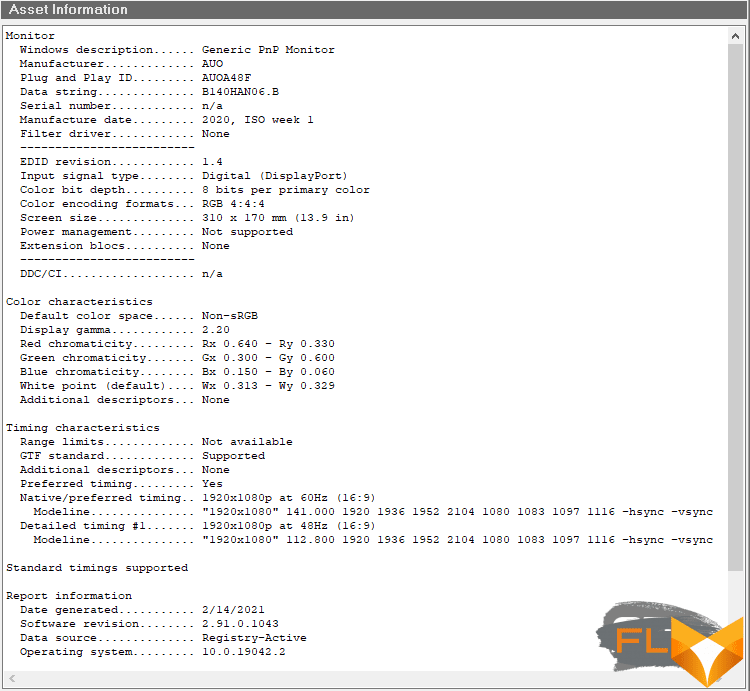
We tested the ultrabook display with the X-Rite i1 Display Pro calibrator and Argyll CMS software with the DispcalGUI graphical interface. All measurements were taken without additional display calibration (factory settings only). Let’s look at the results.

Judging by the DeltaE deviation results obtained, the display is really well calibrated at the factory: the maximum deviation was 2.58 units, and the average was 0.8 units.

The color temperature of the main display of the ultrabook is extremely close to the reference value of 6500 K.

The gamma curve runs in the range from 2.0 to 2.3, but in the interval from 30 to 70% it lies close to the nominal value of 2.2.

Color balance deviations in the gray gradient were recorded only in the range from 5 to 20%.

After calibration, the average deviation of the display matrix was only 0.08 units, and the maximum was 0.61 units. The coverage of the sRGB color space is 105.9%.

In terms of maximum brightness, the ASUS ZenBook Duo 14 UX482E display did not reach the 400 cd/m2 declared in the specifications, but the maximum 364 cd/m2 should be enough even on a sunny day. The minimum value turned out to be 19 cd/m2.

At a brightness level of 200 cd/m2, there are no complaints about the uniformity of the display backlight, with the exception of two small sectors in the lower left corner.
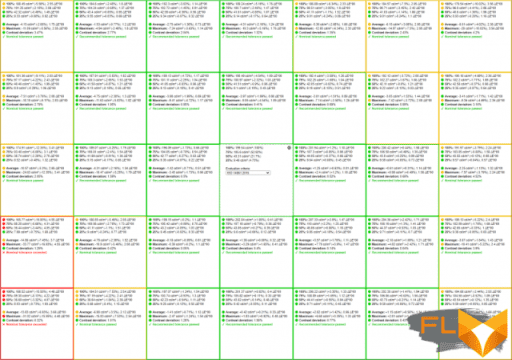
According to the measurement results, we can say that the main display here is exactly the same as in the expensive ASUS ExpertBook B9 B9400CEA, which is why we have an extremely positive overall impression of it.
Recall that, as in many other ASUS ultrabooks, it provides the ability to adjust the color gamut of the display from the proprietary MyASUS application.

Moreover, in the case of ASUS ZenBook Duo 14 UX482, the color scheme can be changed individually for both the main display and the ScreenPad Plus panel.

By the way, the technical characteristics of this panel have not changed: we have an IPS-matrix with a diagonal of 12.65 inches and a resolution of 1920 × 515 pixels. Only higher brightness is declared: 400 cd/m2against the previous 300 cd/m2. There is support for a stylus with the ability to determine the force of pressure, but on the ScreenPad Plus it is quite convenient to work with just your fingers.
The key difference between the updated ScreenPad Plus and the same display in the ZenBook Duo 14 UX481 ultrabook is that when the ultrabook is opened, the additional display rises by 7 degrees, making it easier for the user to perceive two screens as one.

The second important innovation is the specially designed Control Panel, which enhances the user experience when working with two screens. It is shown below in the screenshots from the fourth to the seventh.
 |
 |
 |
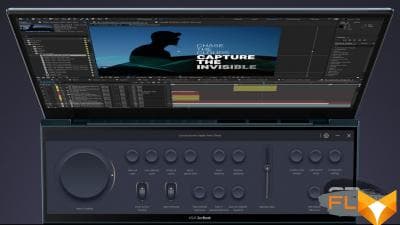 |
 |
 |

This panel is currently designed for Adobe programs: Photoshop, Premiere Pro, Lightroom and After Effects. For example, in Photoshop, with a large round knob, you can increase the size of the brush, and with others you can change its hardness and transparency, set the layer, and so on. It is convenient that the location of any tools on the additional panel and the purpose of their functions is configured as you like – at the request of the user.
At the same time, the previously introduced features of the ScreenPad Plus menu are also preserved.

The possibilities of the second display can be used as much as you have enough imagination. For example, in addition to the banal calculator or the MyASUS utility, you can transfer individual tasks there when editing video / audio content, transfer diagnostic utilities or monitoring graphs to it during benchmarks, and if you get bored with everything at all, you can do handwriting, which, however, you can do and on the main screen-touchpad.
 |
 |
 |
 |
In general, it seems to us that the possibilities of an ultrabook with ScreenPad Plus are truly limitless, and it is now even difficult to predetermine all areas of its application. But this is the plus of all ASUS ZenBook Duo, which now in this regard have become both more convenient and more functional. In addition, the fact that the additional display is raised above the board has made it possible to increase the efficiency of the ultrabook’s cooling system, which we will discuss in the following sections of today’s material.
⇡#Internal device and accessories
The thickness of the ultrabook case reduced by 3 mm, the weight reduced by 50 grams, the more convenient and bright ScreenPad Plus, as well as slightly different ports – all these changes, perhaps, hardly justify the appearance of the new ASUS ZenBook Duo 14 model, and this remark is absolutely fair. , since all the major changes to the ultrabook took place inside its case. First of all, we note changes in the layout of the board and components on it. The cooling system has shifted from the center to the left side and retained only one 10 mm heat pipe.
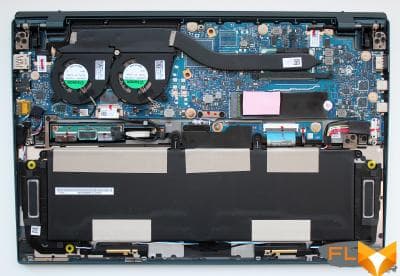 |
 |
At the same time, the battery with stereo speakers and antennas of the wireless communication module did not change externally (as further testing will show, their characteristics have not changed either).
We give a brief summary of the hardware configuration of the ASUS ZenBook Duo 14 UX482EA ultrabook below, and then we will analyze each component separately.

The motherboard of the ultrabook is based on the Intel Tiger Lake chipset, and the latest BIOS version 206 available at the time of testing is dated December 12, 2020.


The first major change is, of course, the CPU. The ultrabook now replaces the Intel Core i7-10510U of the Kaby Lake-U family with power-efficient 11th-generation Tiger Lake-U processors: Intel Core i5-1135G7 or Intel Core i7-1165G7. In our version of the ultrabook, just the second, most productive option is installed.
 |
 |
This processor model has a L3 cache size of 12 MB, a turbo frequency of up to 4.7 GHz, and a TDP of no more than 28 watts.
The next important change is the type of RAM. Instead of the previous LPDDR3 with an effective frequency of 2133 MHz and timings of 16-20-20-45 CR1, the ASUS ZenBook Duo 14 UX482EA has LPDDR4X memory with an effective frequency of 4266 MHz and timings of 36-39-39-97 CR1 .

The amount of memory in an ultrabook can be equal to 8, 16 or 32 GB – and it is impossible to change it, since the chips are soldered on the motherboard.

Judging by the tests, the memory bandwidth in the ultrabook has more than doubled, and this more than compensates for the 7% increase in latency. Our only recommendation in this case is to take the version with 32 GB of RAM.
The third change affected the graphics core. Select versions of the ASUS ZenBook Duo 14 UX482 can be equipped with a 2GB NVIDIA GeForce MX450 discrete graphics card, but our configuration only has Intel Iris Xe graphics integrated into the CPU versus the previous Intel UHD Graphics 620.

And this, in our opinion, is the best option for such an ultrabook, since the NVIDIA GeForce MX450 does not bring a serious performance boost, and in general, the level of this video card does not allow playing modern 3D games at a resolution of 1920 × 1080 pixels. So for now, for the ZenBook Duo 14, the new Intel Iris Xe graphics are everything.
The fourth change affected the drive. And although its type with the interface remained the same (M.2 2280 and NVMe 3.0 x4), the ASUS ZenBook Duo 14 UX482 has a very fast Samsung PM981a SSD (MZVLB1T0HBLR-00000) with a capacity of 1 TB.


According to the test results, it demonstrates very high speed performance when the ultrabook is running both from the mains and in standalone mode from the battery.
 |
 |
|
| ATTO Disk Benchmark (grid) | ATTO Disk Benchmark (Battery) |
 |
 |
|
| AS SSD Benchmark (grid) | AS SSD Benchmark (Battery) |
 |
 |
|
| CrystalDiskMark (mains) | CrystalDiskMark (battery) |
 |
 |
|
| PCMark’10 (power grid) | PCMark’10 (Battery) |
The maximum temperature of the SSD in the stress test did not exceed 53 degrees Celsius, which is a very good result for a compact ultrabook.

SSD stress test when running on AC outlet
But the wireless module in the new ASUS ZenBook Duo 14 UX482 has not changed, it also uses Intel AX201D2W with support for Wi-Fi 6 (802.11ax), MIMO 2 × 2 and the ability to operate at frequencies of 2.4 GHz and 5.0 GHz ( 160 MHz).

The antennas of the wireless module are located in the front of the ultrabook case. At the software level, ASUS WiFi Master technology is implemented, which includes WiFi SmartConnect and WiFi Stabilizer functions.
The Realtek ALC3288 chip is chosen as the audio processor.

The active interaction of ASUS engineers with Harman Kardon specialists made it possible to achieve the output of an exceptionally clear and powerful signal through two stereo speakers built into the base and side sections of the stereo speaker housing.
 |
 |
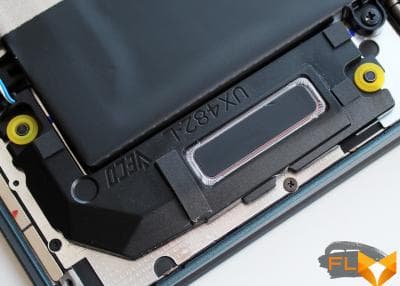 |
 |
We add that the MyASUS software package has a separate section for enabling microphone noise reduction and filtering the output through the acoustics of all sounds, except for the human voice.

The latter feature can be useful for participating in online conferences and briefings.
⇡#Cooling system, efficiency and noise level
The ASUS ZenBook Duo 14 UX482, unlike the UX481, uses a cooling system called Active Aerodynamic System (AAS +) and was previously used in ASUS ROG gaming laptops. Now, due to the fact that the additional screen is raised by 7 degrees, the cooler fans do not receive air from the bottom, through the ventilation grill, but through the slots on the sides, as a result of which the air flow increased by 49% at once. This allows you to cool the processor more efficiently with less noise (40% increase in efficiency is claimed).

In addition, the number of blades in each cooler fan has been increased from 43 to 59 pieces (by 37% at once). One heatpipe with a diameter of 10 mm transfers heat from the processor and discrete graphics card (in our version there is no separate GPU in the laptop).
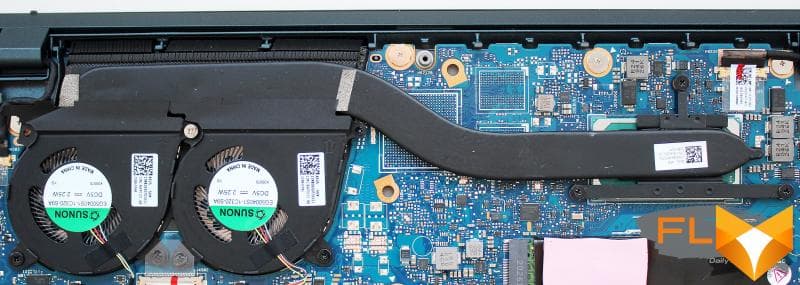
As for the operating modes of the ultrabook and its cooling system, there are still three of them, and they are activated in the MyASUS application.

To evaluate the efficiency of CPU cooling in the ultrabook, we used the powerMAX utility (in AVX mode), and the monitoring parameters were read and displayed by HWiNFO64. Testing was conducted at a room temperature of about 25 degrees Celsius running the Windows 10 Pro x64 operating system with the latest available drivers and updates installed.
We conducted the first three cycles of the stress test of the CPU of the ASUS ZenBook Duo 14 UX482 ultrabook when it was running from the power adapter and the mains, and obtained the following results.
 |
 |
 |
||
|
Performance (2.9GHz, 81°C, 28W) |
Balanced (2.6GHz, 72°C, 22W) |
Silent (1.3GHz, 51°C, 12W) |
In the maximum performance mode, the frequency of the ultrabook processor briefly rises to 4.7 GHz simultaneously with a temperature jump to 94 degrees Celsius, but then stabilizes first at 3.1 GHz, and after 5-6 minutes of stress load – at 2.9 GHz, with a temperature about 80 degrees Celsius and TDP 28 watts. The fans of the cooling system in this mode are clearly audible, but the sound of their work does not cause serious discomfort. Balanced mode stabilizes the processor at 2.6GHz at 72 degrees Celsius and a TDP of 22W, and the cooling system is barely noticeable in noise levels. Finally, in the mode with the speaking name Silent, the ultrabook works silently, but only at 1.3 GHz with a TDP of 12 watts.
Now the same tests, but when disconnected from the power adapter and the mains.
 |
 |
 |
||
|
Performance (2.9GHz, 83°C, 28W) |
Balanced (2.8GHz, 77°C, 23W) |
Silent (1,6GHz, 55 °C, 12 W) |
Surprisingly, when running on battery alone (with it almost fully charged), the ASUS ZenBook Duo 14 UX482 not only does not lose performance, but also accelerates slightly in balanced and quiet modes with an increase in average temperatures by 5 and 4 degrees Celsius. But in the most productive mode, the frequency and temperature of the ASUS ZenBook Duo 14 UX482 processor remained practically unchanged.
⇡#Performance testing
Initially, we planned to test the ASUS ZenBook Duo 14 UX482 in maximum performance mode when connected to the mains and in the same mode, but powered by the built-in battery. However, identical test results showed the futility of this undertaking. Therefore, it was decided to evaluate the performance of the ultrabook in the Performance and Balanced modes.
|
Memory and GPGPU test AIDA64 Extreme (Performance) |
Memory and GPGPU Test AIDA64 Extreme (Balanced) |
|
WinRAR (Performance) |
WinRAR (Balanced) |
|
7-Zip (Performance) |
7-Zip (Balanced) |
|
VeraCrypt (Performance) |
VeraCrypt (Balanced) |
|
HandBrake (Performance) |
HandBrake (Balanced) |
|
Cinebench R20 (Performance) |
Cinebench R20 (Balanced) |
|
Cinebench R23 (Performance) |
Cinebench R23 (Balanced) |
|
Blender 2.91.0 classroom (Performance) |
Blender 2.91.0 classroom (Balanced) |
|
Geekbench 5 (Performance) |
Geekbench 5 (Balanced) |
|
PCMark’10 (Performance) |
PCMark’10 (Balanced) |
|
CompuBench 2.0 (Performance) |
CompuBench 2.0 (Balanced) |
 |
 |
|
GFXBench 5 (Performance) |
GFXBench 5 (Balanced) |
|
3DMark Night Raid (Performance) |
3DMark Night Raid (Balanced) |
|
3DMark Fire Strike (Performance) |
3DMark Fire Strike (Balanced) |
|
3DMark Wild Life (Performance) |
3DMark Wild Life (Balanced) |
|
3DMark Time Spy (Performance) |
3DMark Time Spy (Balanced) |
|
World of Tanks enCore RT (Performance) |
World of Tanks enCore RT (Balanced) |
It is obvious that there are performance losses, but it is difficult to call them critical. In some tests, performance decreased by 1-3%, and in some benchmarks, performance decreased by 20%.
The table with the results will tell us how much the performance of ASUS ZenBook Duo 14 UX482 has increased compared to last year’s ZenBook Duo UX481F, although not all of them were able to oppose each other.
|
Test name |
Measure |
ASUS ZenBook Duo 14 UX482EA |
ASUS ZenBook Duo UX481F |
|
Announcement date |
January’21 |
January’20 |
|
|
AIDA64 memtest |
Read |
63526 |
28349 |
|
Write |
66 724 |
31 329 |
|
|
Copy |
64513 |
29482 |
|
|
Latency |
93.2 |
87.0 |
|
|
WinRAR |
KB/s |
10444 |
7766 |
|
7-Zip |
MIPS |
40984 |
32 871 |
|
HandBrake |
H.265 MKV 4K, s |
651,82 |
– |
|
CineBench R20 |
CPU (Multi Core), pts |
2 229 |
1 486 |
|
CPU (Single Core), pts |
563 |
482 |
|
|
CineBench R23 |
CPU (Multi Core), pts |
5 781 |
– |
|
CPU (Single Core), pts |
1 449 |
– |
|
|
Blender (Classroom) |
Classroom, time |
0:21:48 |
– |
|
Geekbench 5 |
Single-Core Score |
1 543 |
– |
|
Multi-Core Score |
5 534 |
– |
|
|
PCMark’10 |
Total |
5 057 |
3 496 |
|
Essentials |
10 308 |
6 694 |
|
|
Productivity |
6 759 |
5 485 |
|
|
Digital Content Creation |
5 038 |
3 161 |
|
|
3DMark |
Night Raid |
18 127 |
– |
|
Fire Strike |
5 285 |
2 765 |
|
|
Wild Life |
13 440 |
– |
|
|
World of Tanks enCore RT (medium quality) |
Score |
12069 |
5 195 |
|
CompuBench 2.0 |
Level-set Sim. 256, MVoxels/s |
2704.0 |
– |
|
Ocean Surface Sim., It./s |
1449.7 |
– |
|
|
TV-L1 Optical Flow, Mpixels/s |
14,585 |
– |
|
|
GFXBench 5 |
Aztec Ruins (High Tier), Frames |
5232.40 |
– |
|
ALU, Frames |
1,798.44 |
– |
|
|
Render Quality, mB PSNR |
2561.97 |
– |
As you can see, in those tests where both ultrabooks were tested, the new model with a processor from the Tiger Lake-U family leaves a noticeable lead.
⇡#Autonomous
All versions of ASUS ZenBook Duo 14 UX482 ultrabooks are equipped with a 65 W (20.0 V, 3.25 A) power adapter model AD2129320, weighing 215 grams, with a built-in 1.57 m USB Type-C cable.

The specifications of the ultrabook indicate that such an adapter charges the ASUS ZenBook Duo 14 UX482 lithium-ion battery with a capacity of 70 Wh from 0 to 60% in 49 minutes.
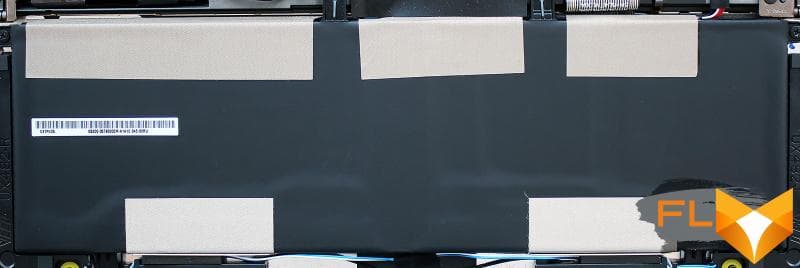
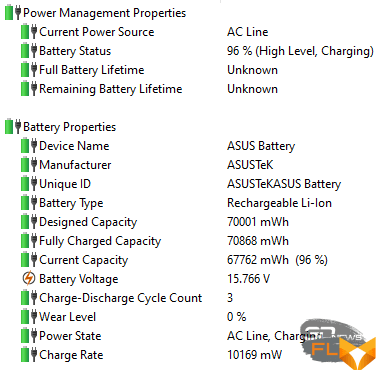
Indeed, the ultrabook reaches the level of 60% quite quickly, but the time for a full battery charge – from 3 to 99% – is 1 hour 58 minutes (averaged over four full charge cycles). At the same time, the ASUS ZenBook Duo UX481F model with the same capacity battery and the same power adapter charged 40 minutes longer.
Recall that MyASUS has three battery charge modes: to full capacity, balanced (recommended) and maximum life mode.

We ran our first batch of ASUS ZenBook Duo 14 UX482 battery life tests with the main display brightness set to 200 cd/m2 (75% on scale) and the ScreenPad Plus display turned off. Testing was carried out using the PCMark’10 package in Modern Office, Applications, Gaming and Video modes. Network connections and sound did not turn off. We were very impressed with the results: up to 17 hours in everyday work, up to 12 hours when watching full-screen video and more than three hours in a conditional game mode.
|
PCMark’10 “Modern Office” (12 hours 43 minutes) |
PCMark’10 «Applications» (17 ч 19 мин) |
|
PCMark’10 «Gaming» (3 ч 20 мин) |
PCMark’10 «Video» (11 ч 51 мин) |
If we conduct the same tests with ScreenPad Plus enabled, which is more relevant in the context of the intended use of ASUS ZenBook Duo 14 UX482, then the battery life in Modern Office is reduced by 1 hour 23 minutes, in Applications – by 2 hours 5 minutes, and in Gaming the result has not changed, all the same three and a third hours. In the video playback mode, the second screen is not needed, so we did not repeat this test with the activated ScreenPad Plus. In any case, the results are excellent, the autonomy of the ultrabook is at a very high level.
⇡#Conclusion
Behind the external similarity of the ASUS ZenBook Duo 14 UX482 with its predecessor lies a deep modernization of the ultrabook, both in terms of ergonomics and ease of use, and in terms of hardware. In fact, only the main display has not changed, and the developers tried to improve everything else, which they managed to do almost completely, with the exception of for some reason reduced arrows on the keyboard and a camera with a resolution of 720p. Ergonomic optimizations include a 3 mm thinner ultrabook case, slightly reduced weight, a more user-friendly ScreenPad Plus display with increased brightness and a control panel for Adobe products.
Changes in the hardware component deserve a separate paragraph. Here, first of all, we should note a more powerful Tiger Lake-U processor with integrated Intel Iris Xe graphics, the fastest (for ultrabooks) LPDDR4X 4266 MHz RAM, a terabyte SSD with comprehensive speed performance, and a wireless network adapter with Wi-Fi 6 support and Harman Kardon certified sound. The redesigned cooling system, which was given a second wind thanks to the rise of the ScreenPad Plus, manages to cool the processor without excessive noise. We especially note that the ultrabook does not lose performance when running on battery power, as happens with most other models.
At the height of the ASUS ZenBook Duo 14 UX482 is such an important indicator for ultrabooks as autonomy. A full charge of the battery is enough for 10 hours of simultaneous work with two touchscreen displays, activated network and sound, and only with the main display this miniature and at the same time productive computer is able to work for more than 17 hours! In general, it turned out to be certainly an interesting, compact and long-playing machine. The only pity is that it costs too much.
FAQ Asus zenbook duo 14 ux482
What are the key features of the ZenBook Duo 14 UX482?
The ZenBook Duo 14 UX482 features a tilting ScreenPad Plus, an FHD touch display, Intel Core i7-1165G7 CPU, and up to 32GB RAM, offering a unique dual-screen experience for multitasking.
Does the ZenBook Duo 14 come with Windows 10 Home or Windows 11 Pro?
The ZenBook Duo 14 comes with Windows 10 Home, but it is eligible for a Windows 11 upgrade, allowing users to enjoy the latest operating system features.
What kind of storage does the ZenBook Duo 14 UX482 offer?
The ZenBook Duo 14 UX482 offers a 512GB PCIe SSD, providing fast boot times and quick data access.
How does the Intel Core i7-1165G7 CPU benefit the ZenBook Duo UX481?
The Intel Core i7-1165G7 CPU in the ZenBook Duo UX481 ensures efficient performance for both everyday tasks and more demanding applications, thanks to its powerful processing capabilities.
What type of graphics card is included in the ZenBook Duo with the Core i7-1165G7 CPU?
The ZenBook Duo with the Core i7-1165G7 CPU includes GeForce MX450 graphics, providing decent graphical performance for creative work and casual gaming.
Can you upgrade the ZenBook Duo 14 UX482 to Windows 11 Pro from Windows 10 Home?
Yes, the ZenBook Duo 14 UX482 can be upgraded from Windows 10 Home to Windows 11 Pro, allowing users to take advantage of the newer OS’s enhanced features and capabilities.
What is the maximum RAM capacity available in the ZenBook Duo series?
The ZenBook Duo series, like the UX482, offers models with up to 32GB RAM, providing ample memory for demanding multitasking and creative projects.
How does the PCIe SSD in the ZenBook Duo 14 enhance its performance?
The PCIe SSD in the ZenBook Duo 14 ensures fast boot times and rapid data retrieval, significantly enhancing the overall system performance and user experience.
What audio technology does the ZenBook Duo utilize?
The ZenBook Duo utilizes ASUS SonicMaster audio technology, developed in collaboration with the ASUS Golden Ear team, ensuring a rich and immersive audio experience.
Is the ZenBook Duo 14 UX482 a touchscreen laptop?
Yes, the ZenBook Duo 14 UX482 is a touchscreen laptop, offering an intuitive and interactive user experience with both its main display and the secondary ScreenPad Plus.
What processor is featured in the ZenBook Duo 14 UX482?
The ZenBook Duo 14 UX482 is powered by the 11th generation Intel Core i7-1165G7 processor, offering robust performance for various computing needs.
How much RAM does the ZenBook Duo 14 UX482 come with?
The ZenBook Duo 14 UX482 typically comes with 8GB RAM, which is suitable for efficient multitasking and smooth performance in standard applications.
What is the main advantage of the Intel Evo platform in the ZenBook Duo 14?
The Intel Evo platform in the ZenBook Duo 14 ensures fast responsiveness, long battery life, and instant wake from sleep, providing an efficient and user-friendly experience.
How does the 11th Gen Intel Core processor benefit the ZenBook Duo series?
The 11th Gen Intel Core processor in the ZenBook Duo series provides a significant performance boost, ensuring that the laptop can handle demanding applications and multitasking with ease.
What are the storage options available in the ZenBook Duo 15?
The ZenBook Duo 15 offers a variety of storage options, including a 1TB PCIe SSD, ensuring ample space for files and quick data access.
What distinguishes the Pro Duo 15 OLED from other laptops in the series?
The Pro Duo 15 OLED stands out with its stunning OLED display, offering vibrant colors and deep blacks, perfect for creative professionals and multimedia enthusiasts.
Can the ZenBook Duo 14 also support intensive multitasking?
Yes, the ZenBook Duo 14 can support intensive multitasking, thanks to its powerful Intel Core processors combined with plenty of fast RAM and a fast SSD.
Is the ZenBook Duo 14 available for purchase on the ASUS eShop USA?
Yes, the ZenBook Duo 14 is available for purchase on the ASUS eShop USA, where customers can explore various configurations and features of the new ZenBook Duo.
What audio technology has ASUS integrated into the ZenBook Duo 14?
ASUS has integrated the latest iteration of ASUS SonicMaster audio technology into the ZenBook Duo 14, which was developed in collaboration with the ASUS Golden Ear team to enhance audio quality.
How does the ZenBook Duo 14 utilize its dual screens?
The ZenBook Duo 14 gives users the flexibility to use the dual screens for various tasks, such as extending the main screen or splitting windows and apps across both displays for improved productivity.

